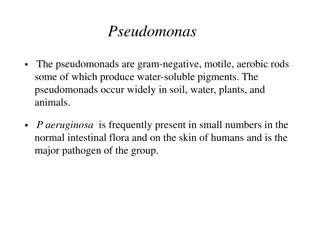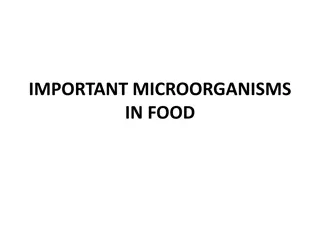Wales in a global context: enhancing learners’ skills
World of bacteria through the lens of mathematics and science. This educational material delves into the characteristics, importance, and impact of bacteria on the environment and human health. From their small single-celled structures to their role in ecosystems, learn about the significance of bac
0 views • 10 slides
Bacterial Biochemical Identification Tests in Microbiology
Understand the significance of biochemical tests like the Triple Sugar Iron Agar Test (TSI) and the IMViC Test for identifying enteric bacteria. Learn about indole production, methyl red test, and other methods used in bacteriology.
5 views • 17 slides
Exploring the Fascinating World of Bacteria: Types, Shapes, and Structures
Delve into the diverse characteristics of bacteria, from their food sources to shapes and major cell structures. Discover how bacteria play a crucial role in various environments, from soil to the human body.
0 views • 39 slides
Understanding Bacteria Cultures and Growth: Key Concepts and Practical Tips
Scientists culture bacteria to study them effectively. Differentiating between bacteria and viruses, maintaining precautions when handling bacteria cultures, and controlling their spread are vital. Tasks like watching relevant videos, self-assessments, steps for growing useful microorganisms provide
0 views • 17 slides
Understanding the Gram Stain Technique in Medical Microbiology Lab
The Gram stain is a crucial technique in bacteriology, dividing bacteria into Gram-positive and Gram-negative groups based on cell wall characteristics. This method involves using crystal violet, iodine, ethanol, and safranin to differentiate between the two types of bacteria. Gram-positive bacteria
0 views • 11 slides
Understanding Enteric Fever (Typhoid Fever): Causes, Contagiousness, and Prognosis
Enteric fever, commonly known as typhoid fever, is an acute illness caused by Salmonella typhi bacteria transmitted through contaminated food or water. This fever is highly contagious, with individuals becoming carriers even after recovering. Close contact, contaminated water, and poor sanitation co
0 views • 18 slides
Understanding Gelatin Capsules in Pharmaceutical Formulations
Gelatin capsules are versatile dosage forms used to encapsulate various types of medicinal agents. This article explores the types of gelatin capsules, including hard, soft, and enteric-coated capsules, their composition, uses, and storage requirements. Gain insights into the differences between the
1 views • 16 slides
Overview of Clostridial Diseases Caused by Clostridium Bacteria
Clostridial diseases are caused by bacteria of the genus Clostridium, which are anaerobes commonly found in soil, feces, and healthy animal tissues. These bacteria can lead to various diseases in animals such as black quarter, gas gangrene, necrotic dermatitis, and more. Understanding the different
0 views • 55 slides
Understanding Biochemical Tests for Bacterial Identification
Explore the importance of biochemical tests like Triple Sugar Iron Agar and IMViC in identifying enteric bacteria. Learn about indole production and the Methyl Red test, essential in distinguishing bacterial species based on their metabolic activities. Discover how these tests aid in diagnosing food
2 views • 17 slides
Understanding Film Forming Agents for Tablet Coating in Pharmaceuticals
Film forming agents play a crucial role in tablet coating, providing mechanical strength and desired film characteristics. Non-enteric film formers like HPMC, MHEC, EC, HPC, Povidone, SCMC, and PG Acrylate Polymers are commonly used for uniform film formation. Each agent has unique properties and pr
1 views • 10 slides
Understanding Anaerobic Bacterial Growth and Culturing Methods
Anaerobic bacteria have specific sensitivities to oxygen, with categories such as aerobic, obligate anaerobes, facultative anaerobes, aerotolerant anaerobes, microaerophiles, and capnophilic bacteria. Methods like Anaerobic Jar and GasPak system are used for cultivating anaerobic bacteria, ensuring
0 views • 7 slides
Understanding Triple Sugar Iron Agar (TSI Agar) Test
Triple Sugar Iron Agar (TSI Agar) is a differential media used for identifying gram-negative enteric bacilli based on carbohydrate fermentation and hydrogen sulfide production. It helps detect carbohydrate fermentation, gas production, acidification, and H2S formation, providing valuable information
1 views • 28 slides
Overview of Streptococcus Bacteria and Classification
Streptococcus is a genus of gram-positive bacteria commonly found on skin and mucous membranes. It includes pathogenic and non-pathogenic species, with cell division along a single axis forming pairs or chains. The bacteria were first observed by Billroth and named by Ogston. Different types of stre
0 views • 28 slides
Understanding the Spoilage Flora in Raw Meat Products
Raw meat products are highly perishable due to the presence of various spoilage bacteria, yeasts, and molds. Factors such as nutrient availability, oxygen levels, storage temperature, and pH influence the predominant spoilage flora in meat. Psychrotrophic bacteria thrive in refrigerated storage, lea
0 views • 17 slides
Insights into Bacteria Reproduction and Cell Division
Explore the fascinating world of bacteria reproduction through binary fission, conjugation, and mitosis. Uncover the similarities and unique aspects of prokaryotic and eukaryotic cell division processes. Learn how conjugation plays a vital role in transferring genetic information between bacteria ce
0 views • 21 slides
Understanding the Triple Sugar Iron Test in Biochemical Analysis
The Triple Sugar Iron Test (TSI) is a crucial biochemical test used to differentiate gram-negative enteric bacilli based on their carbohydrate fermentation and hydrogen sulfide production. By examining color changes, gas production, and precipitate formation, microbiologists can interpret TSI result
2 views • 31 slides
Understanding Viral Gastroenteritis: Causes, Symptoms, and Transmission
Viral gastroenteritis, commonly known as viral diarrhea, is a prevalent infection affecting mainly infants and young children. The disease is self-limiting, with symptoms like diarrhea, vomiting, and abdominal pain. Key viral etiologies include Rota viruses, Astroviruses, Norovirus, and Enteric aden
0 views • 19 slides
Trickling Filter: A Sustainable Wastewater Treatment Solution
The trickling filter is a biological treatment process utilizing a solid media where bacteria accumulate to maintain high populations. Bacteria growth occurs on the media surface with oxygen provided by air diffusion. As bacteria metabolize waste, they reproduce, creating a biological layer. Filter
5 views • 26 slides
Understanding Bacterial Cell Structure and Function
Bacteria display unique cellular structures and functions that differ from eukaryotic cells. They have a simple structure with a plasma membrane but lack complex internal membrane systems. The cytoplasm contains inclusion bodies, ribosomes, and genetic material in the nucleoid. Bacteria can be categ
4 views • 21 slides
Bacteria Identification Techniques: Staining and Microscopy Overview
Staining techniques in microbiology play a crucial role in visualizing bacteria under microscopes. This content covers the importance of staining, types of dyes, wet and dry mounts, hanging drop technique, and different types of staining methods employed in identifying bacteria. Explore the basics o
0 views • 39 slides
Understanding Pseudomonas and Proteus Bacteria
Pseudomonas is a group of gram-negative, motile, and aerobic bacteria found in various environments, with Pseudomonas aeruginosa being a significant pathogen in humans. It can produce distinctive pigments and is resistant to many antimicrobial agents. Lab diagnosis involves culture testing on specif
0 views • 17 slides
Important Bacterial Groups in Food
Bacteria play a crucial role in food, with various groups such as Lactic Acid Bacteria, Acetic Acid Bacteria, Propionic Acid Bacteria, Butyric Acid Bacteria, Proteolytic Bacteria, Lipolytic Bacteria, Saccharolytic Bacteria, and Pectinolytic Bacteria identified for their specific roles in food fermen
0 views • 17 slides
Cutting-Edge Research Equipment and Studies at The Aga Khan University, Pakistan
The research facilities at The Aga Khan University in Pakistan boast state-of-the-art equipment for groundbreaking studies in areas like enteric fever prevention, rotavirus vaccine impact assessment, and dental stem cells. Researchers utilize specialized tools such as refrigerated centrifuges, biosa
0 views • 29 slides
Comparison of Archaebacteria & Eubacteria Venn Diagram
Archaebacteria and Eubacteria are two types of bacteria with distinct characteristics. Archaebacteria are ancient bacteria that are extremophiles, living in harsh environments like hydrothermal vents and volcanoes, lacking peptidoglycan. On the other hand, Eubacteria are true bacteria with peptidogl
0 views • 60 slides
Understanding How Viruses, Bacteria, and Fungi Impact Human Health
Explore the intricate world of viruses, bacteria, and fungi and how they interact with living organisms. Learn about the structure and functions of viruses, the role of bacteria in diseases, and the implications of fungi on human health. Discover the different ways these microorganisms affect us and
0 views • 37 slides
Understanding Plant Pathology: Reproduction and Classification of Bacteria
This course on Fundamentals of Plant Pathology, led by Mr. Vikash Kumar, covers essential topics such as disease identification, pathogen nature, disease management strategies, pathogen classification, and plant disease diagnosis. It delves into the reproduction and classification of plant pathogeni
0 views • 16 slides
Interactions Between Bacteria and Methanogens in the Rumen
The rumen, an anaerobic fermentation chamber in ruminant animals, houses a diverse microbial community including bacteria, fungi, protozoa, methanogenic archaea, and phages. Methanogens play a crucial role in methane production using fermentation end products. Research aims to explore evidence of in
0 views • 21 slides
Understanding Viruses and Bacteria: A Biology Presentation by Mandie Lynn Walls
Explore the world of viruses and bacteria through this engaging biology presentation put together by Mandie Lynn Walls. Learn about the structure of viruses, different types of viruses like T4 Bacteriophage and Herpes Virus, the distinction between viruses and bacteria such as E. coli, vaccination m
0 views • 39 slides
Understanding Triple Sugar Iron Agar (TSI Agar) Test in Microbiology
Gain insights into the Triple Sugar Iron Agar (TSI Agar) test used for differentiating gram-negative enteric bacilli based on carbohydrate fermentation and hydrogen sulfide production. Learn about detecting carbohydrate fermentation, interpreting results, and performing the test accurately with deta
0 views • 28 slides
Overview of Gram-Negative Enteric Bacilli
Gram-negative bacilli are a diverse group of bacteria, including enteric and non-enteric bacilli. Common characteristics include being aerobic or facultative anaerobes, fermenting glucose, and being part of the normal flora of the human and animal gastrointestinal tract. Escherichia coli (E. coli) i
0 views • 27 slides
Overview of Salmonella Infections and Pathogenicity
Salmonella bacteria, often transmitted through contaminated food or drink, can cause various infections in humans and animals. They are identified by their morphology, and classified into different species and subtypes. The pathogenesis of Salmonella infections varies, with some species infective pr
0 views • 18 slides
Salmonellosis: Understanding the Disease and Its Implications
Salmonellosis is a bacterial infection caused by various serotypes of the Salmonella bacteria. The disease is transmitted through contaminated food, direct contact with infected animals, or the fecal-oral route in endemic areas. Typhoidal Salmonella serovars can lead to serious conditions like enter
0 views • 23 slides
Understanding the Role of Gut Bacteria in Obesity and Metabolic Disease
Trillions of bacteria in our gut play a crucial role in obesity and metabolic diseases. By analyzing studies on antibiotic effects, bacterial composition, and diet impact, we learn how gut bacteria influence weight gain, energy use, and overall health. Research shows diverse bacterial types affect w
0 views • 16 slides
Integrated Pest Management and the Use of Probiotics in Broiler Production
Tips for broiler producers include implementing integrated pest management strategies and utilizing probiotics in poultry feeds to enhance gut health, control diseases, and improve productivity. With concerns over antibacterial resistance, alternatives to antibiotics such as probiotics and prebiotic
0 views • 13 slides
New Requirements for PRRS & SECD Testing in Swine
The new rule mandates testing for Porcine Reproductive Respiratory Syndrome (PRRS) and Swine Enteric Corona Virus Disease (SECD) in swine moving into or within Wisconsin, with specific guidelines for testing, movement to exhibitions, and commercial farm scenarios. The rules also outline procedures f
0 views • 11 slides
Food Safety: Control Temperature to Prevent Bacteria Growth
Understand the importance of controlling food temperature to keep it safe from bacteria growth. Learn about the temperature danger zone, where bacteria thrive, and the proper handling procedures for buying, storing, cooking, holding, and reheating food. By following these guidelines, you can ensure
0 views • 17 slides
Understanding Bacteriophages and Antibiotic Resistant Bacteria
Explore the relationship between bacteriophages and bacteria, the survival advantage of polyvalency, and the impact of unfavorable conditions on species survival. Discover how manipulation of experiment variables helps establish resistance thresholds and how compounded negative effects affect specie
0 views • 9 slides
Understanding Coronavirus: Prevention and Safety Measures
Coronaviruses are single-stranded RNA viruses that infect birds, mammals, and humans. They can cause respiratory and enteric diseases, hepatitis, and neurologic issues. Initially of veterinary interest, coronavirus spread has escalated into human-to-human transmission. WHO recommends handwashing, co
0 views • 13 slides
Rising to the Challenge of Multidrug-Resistant Gram-Negative Bacteria
The presentation discusses the alarming rise of multidrug-resistant Gram-negative bacteria, highlighting the threat they pose to public health and the economy. Notable figures like Dr. Tom Frieden and Dame Sally Davies emphasize the urgency of taking action to prevent a potential return to a pre-ant
0 views • 58 slides
Detailed Overview of Bacteria's Structure and Function
Explore the world of bacteria with a focus on their microscopic nature, general characteristics, ultrastructure of bacterial cells, and components like cell envelope, cytoplasm, and nuclear material. Uncover the diverse forms of bacteria, their mode of nutrition, reproduction methods, and unique fea
0 views • 12 slides







































